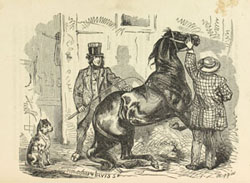
Slow Horses Made Fast and Fast Horses Made Faster. New York: Jesse Haney & Co., 1871. |

The Spider and the Fly; or, Tricks, Traps, and Pitfalls of City Life. New York: C. Miller & Co., 1873. |
| |
Integral to the 19th-century industrialized city, horses pulled vehicles carrying everything from people to produce. By the end of the century, there were nearly 400 horses per square mile in cities in the Northeast, and over 540 in the Midwest. The market for these costly animals invited misrepresentation (like used car sales today). The author of The Spider and the Fly observes that “there cannot be conceived a race of more arrant cheats and swindlers than the whole set of jockeys, grooms, and horse-dealers.” He details the many ways people could be cheated when buying and selling horses. Shown here, a formerly sound horse has been lamed after purchase so that the remorseful buyer can return him.
Similarly, Slow Horses Made Fast enumerates the many ways to win at horse racing, such as fixing the consistency of the track to one’s own horse’s advantage, whipping competing horses while passing, and poisoning them before the race.
Dealers used so many ingenious tricks that “horse-trading” became a positive term, synonymous with clever bargaining. |

